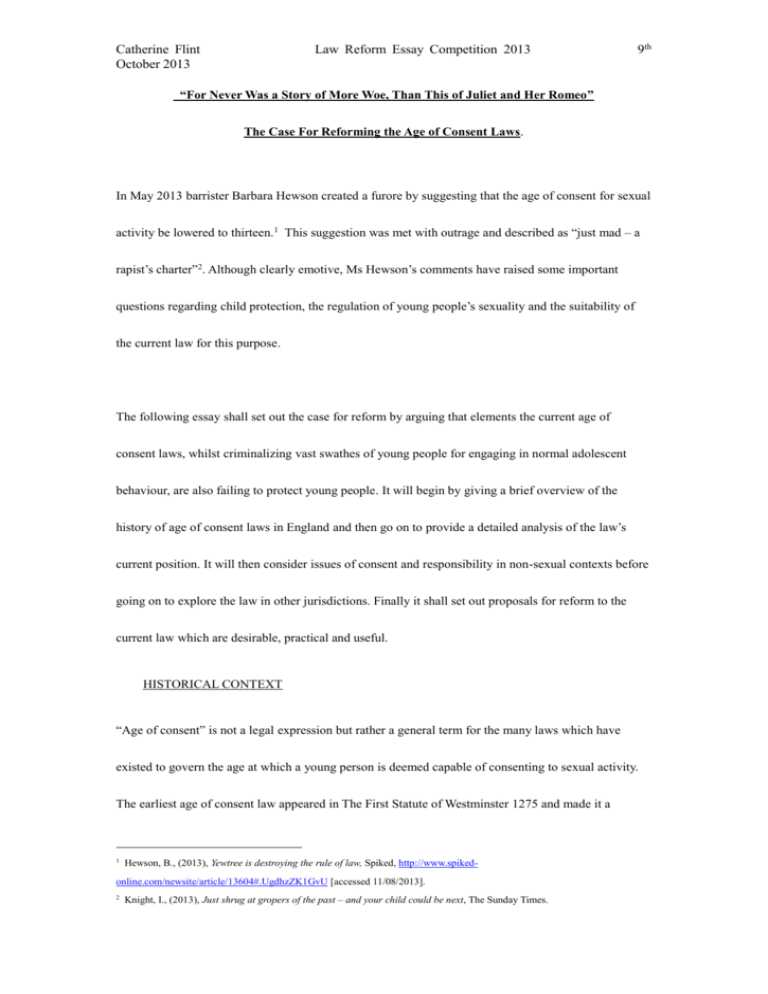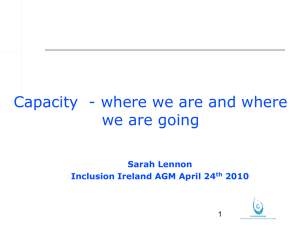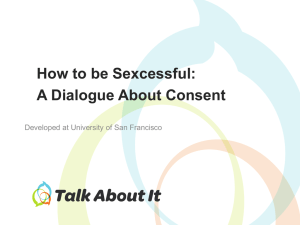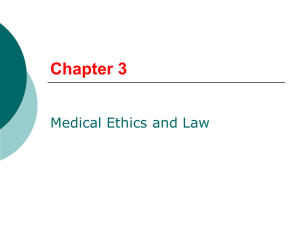
Catherine Flint
October 2013
Law Reform Essay Competition 2013
9th
“For Never Was a Story of More Woe, Than This of Juliet and Her Romeo”
The Case For Reforming the Age of Consent Laws.
In May 2013 barrister Barbara Hewson created a furore by suggesting that the age of consent for sexual
activity be lowered to thirteen.1 This suggestion was met with outrage and described as “just mad – a
rapist’s charter”2. Although clearly emotive, Ms Hewson’s comments have raised some important
questions regarding child protection, the regulation of young people’s sexuality and the suitability of
the current law for this purpose.
The following essay shall set out the case for reform by arguing that elements the current age of
consent laws, whilst criminalizing vast swathes of young people for engaging in normal adolescent
behaviour, are also failing to protect young people. It will begin by giving a brief overview of the
history of age of consent laws in England and then go on to provide a detailed analysis of the law’s
current position. It will then consider issues of consent and responsibility in non-sexual contexts before
going on to explore the law in other jurisdictions. Finally it shall set out proposals for reform to the
current law which are desirable, practical and useful.
HISTORICAL CONTEXT
“Age of consent” is not a legal expression but rather a general term for the many laws which have
existed to govern the age at which a young person is deemed capable of consenting to sexual activity.
The earliest age of consent law appeared in The First Statute of Westminster 1275 and made it a
1
Hewson, B., (2013), Yewtree is destroying the rule of law, Spiked, http://www.spiked-
online.com/newsite/article/13604#.UgdhzZK1GvU [accessed 11/08/2013].
2
Knight, I., (2013), Just shrug at gropers of the past – and your child could be next, The Sunday Times.
Catherine Flint
October 2013
Law Reform Essay Competition 2013
9th
misdemeanour to “ravish” a “maiden within age” with or without her consent. “Within age” being
twelve3. The age of consent remained at twelve until the nineteenth century. An emerging social purity
movement, in which campaigners increasingly sought to regulate sexual behaviour, saw the age at
which girls could consent to sexual intercourse increase from twelve to thirteen4. In 1885 the Pall Mall
Gazette published an exposé on child prostitution, ‘A Maiden Tribute of Modern Babylon’ which
suggested young girls were ‘too young in fact to understand the nature of the crime of which they are
the unwilling victims.’5 This saw the age of consent for girls raised to sixteen by the Criminal Law
Amendment Act (CLAA) 1885.
A corresponding ‘age of consent’ for boys engaging in heterosexual intercourse did not exist whereas
buggery, defined as anal penetration, had long been an offence. S.11 of the CLAA 1885 made ‘gross
indecency’ a crime, extending buggery laws to include any kind of sexual activity between men. This
remained the case until the Sexual Offences Act 1967 decriminalised homosexual acts in private
between two men, if both were over twenty-one, the reason cited for the disparity between the heteroand homosexual age of consent being:
a boy is incapable at the age of sixteen of forming a mature judgement about actions of a kind
which might have the effect of setting him apart from the rest of society.6
It was nearly thirty years until the age was lowered to eighteen by the Criminal Justice and Public
Order Act 1994 before equality with the heterosexual age of consent was finally attained by way of the
Sexual Offences (Amendment) Act 2000. It is worth noting at this point the prevalence of protection as
3
Robertson, S., Age of Consent Laws, Children and Youth in History, Item #230, http://chnm.gmu.edu/cyh/teaching-modules/230
[accessed 23/09/2013].
4
S.51 of the Offences Against the Person Act 1875
5
Stead, W.T., (1885), A Maiden Tribute of Modern Babylon, The Pall Mall Gazette.
6
Ibid., p.99 citing the Committee on Homosexual Offences and Prostitution (1957).
Catherine Flint
October 2013
Law Reform Essay Competition 2013
9th
the prevailing justification for age of consent laws and it is this underlying principle which has
informed the
law’s most recent manifestation.
SEXUAL OFFENCES ACT 2003
The introductory text of the Sexual Offences Act 2003 (the Act) sets out its purpose as:
to make new provision about sexual offences, their prevention and the protection of children from
harm.
The Act has created three ages of consent, depending on circumstance, with thirteen being the age of
absolute protection. Offences committed against children below this age are of strict liability. Sexual
activity with a child (s.9) applies when:
A person aged over 18 (A)...intentionally touches another person (B), the touching is sexual, and
either B is under sixteen and A does not reasonably believe that B is sixteen or over, or B is under
13 (S.9(1)).
Ss.10-12 create offences in the same terms with regard to ‘causing or inciting a child to engage in
sexual activity’, ‘engaging in sexual activity in the presence of a child’, and ‘causing a child to watch a
sexual act’. S.13 prohibits the same range of sexual activity as ss.9-12 but relates to under-eighteens
engaging in this behaviour with under-sixteens. Where there is an abuse of a position of trust (s.16),
sexual activity with a child family member (s.25), paying for sexual services of a child (s.47) or
causing or inciting child pornography (s.48), the age of consent is eighteen. Where a child is over the
age of thirteen, factual consent only becomes valid if the defendant reasonably believed the
complainant to either be over sixteen or eighteen, depending on context.
This most recent legislation, although more egalitarian in terms of gender-neutrality, is in many ways
Catherine Flint
October 2013
Law Reform Essay Competition 2013
9th
more protectionist than previous age of consent laws. Home Office consultations undertaken prior to
the implementation of the Act recognised that whilst the age of consent protects children from adults, it
also affects sexual activity between children. 7 There is no argument that some adults do abuse their
positions of trust and authority to engage in sexual activity with children and there is now a much
greater understanding of the dynamics of this type of abuse and its inherent power imbalance.
Therefore it seems eminently sensible that children and young people should be afforded greater
protection from adults who seek to abuse familial relationships or positions of trust (as defined in s.21)
for their sexual gratification. It is not the intention of this essay to argue against these provisions.
Similarly, it is not being suggested that sex in commercial contexts, such as prostitution or
pornography, should be sanctioned for under-eighteens. Consequently, some of the more protectionist
provisions of the Act are considered fit for purpose. However, the other provisions in question are more
problematic. S.9 ostensibly seeks to provide children the same protection from predatory adults as ss.16
and 25, albeit without the requisite relationships, further emphasising society’s disapproval of adult
sexual activity with children. Sexual abuse of children is harmful and the law needs to be able to not
only punish those who harm children, but also send a clear message that certain behaviours will not be
tolerated. However, research shows that age-span relationships where typically adolescent girls engage
in sexual activity with older boyfriends are a ‘conventional feature of contemporary heterosexuality’.8
Not all of these relationships are abusive but they are criminalised under the current legislation
nonetheless. It has been argued that:
An immature choice about whether to engage in sexual intercourse...can [not] be truly regarded as
7
Home Office, (2000), Setting the Boundaries, Home Office Communication Directorate, p.33.
8
Waites, (2005), p188.
Catherine Flint
October 2013
Law Reform Essay Competition 2013
9th
consensual. When a slightly older partner...exploits his or her age or experience to coerce... a
younger partner into sexual relations...a criminal offence should remain. 9
Coercion is an interesting concept and one that is raised again in discussions about the implementation
of s.13: sexual activity between children and young people. This provision criminalises all intentional
sexual touching by under-eighteens of under-sixteens. Under s.78:
Penetration, touching or any other activity is sexual if a reasonable person would consider that...it
is because of its nature sexual, or because of its nature it may be sexual and because of its
circumstances or the purpose of any person in relation to it...it is sexual.
Therefore all sexual activity, including kissing, between young people is unlawful. Clearly, the
practicalities of fully enforcing this law are unworkable. According to recent research a quarter of girls
and nearly a third of boys have had heterosexual intercourse before the age of sixteen and the median
age for first sexual activity is fourteen for girls and thirteen for boys 10. If the law is seeking to act as a
deterrent it is markedly ineffective and begs the question whether it is truly fit for purpose. However,
the explanatory notes to the Act state:
In practice...decisions on whether persons under eighteen should be charged with child sex
offences will be made by Crown Prosecutors...In deciding whether it is in the public interest to
prosecute these offences...prosecutors may take into consideration factors such as the ages of the
parties; the emotional maturity of the parties; whether they entered into a sexual relationship
willingly; any coercion or corruption by a person; and the relationship between the parties.
These suggestions are supported by current Crown Prosecution Service policy.11 Words such as
9
Home Office, (2000), Setting the Boundaries, Home Office Communication Directorate, p.42.
10
Knight, S., (2012), Libertarian critiques of consent in sexual offences, UCL Journal of Law and Jurisprudence, p.11.
11
Prosecution Policy and Guidance, The Crown
Prosecution Service
Catherine Flint
October 2013
Law Reform Essay Competition 2013
9th
coercion, intimidation and corruption are used to justify the existence of s.13, with the caveat that a
prosecution will only be pursued when these elements are present. However, s.74 of the Act contains
the first ever statutory definition of ‘consent’ and states:
A person consents if he agrees by choice, and has the freedom and capacity to make that choice.
If the prosecuting authorities have sufficient evidence of coercion, intimidation or corruption to pursue
a prosecution under s.13, any meaningful consent, for the purposes of the Act, has been negated.
Therefore, if the true purpose of s.13 is to protect children from the exploitative behaviour of other
children this would be better served by utilising other sections of the Act without criminalising vast
swathes of young people for engaging in normal adolescent behaviour. This is as true for underthirteens as it is for under-sixteens. Whilst it is recognised that sexual activity amongst younger
adolescents is not desirable, the existence of an absolute age of protection is unrealistic and can lead to
injustice. The average age for menarche is now twelve, with boys starting puberty around the same
time.12 It is patently unfair that the defence of mistake is not available when a child not only looks
older but has misled the other party as to their age. It should not, for peers engaging in consensual
sexual activity as Baroness Hale stated in R v G, be ‘a risk that she may be younger than he thinks she
is’13 if what is being risked is a conviction for rape. The law relating to under-thirteens also creates a
fundamental absurdity where a child can on the one hand be held incapable of consenting to sexual
activity but on the other be criminally responsible for rape and sexual assault. The current law, in
denying young people agency and placing them firmly in a position of non-autonomous passivity, as
http://www.cps.gov.uk/legal/s_to_u/sentencing_manual/s_9_s13_sexual_activity_with_a_child_youth/ [accessed 08/10/2013]
12
NHS, Puberty, http://www.nhs.uk/Conditions/Puberty/Pages/Introduction.aspx [accessed
08/10/2013].
13
[2009] 1 A.C. 92
Catherine Flint
October 2013
Law Reform Essay Competition 2013
9th
well failing to protect them from both themselves and each other, is also painfully at odds with other
areas of the law which deal with the autonomy and responsibility.
COMPETENCY AND RESPONSIBILTY
In 1985 the House of Lords ruled:
Whether or not a child is capable of giving the necessary consent will depend on the child’s
maturity and understanding and the nature of the consent required. 14
The test for ‘Gillick Competence’ now forms the basis for deciding whether a child is capable of
consenting to medical treatment. This approach takes into consideration not only whether the child
understands ‘the nature of the advice which is being given; [but] she must also have sufficient maturity
to understand what is involved’15. This level of nuance is echoed in s.1(3)(a) of the Children Act 1989
which holds the court must have ‘regard in particular to the ascertainable wishes and feelings of the child
concerned (considered in light of his age and understanding)’ whenever a question with respect to the
upbringing of a child arises. These provisions show a far greater understanding of child development and
a more enlightened approach to childhood autonomy than the current age of consent laws. However, such
tests may be more suited to situations where professionals are being called upon to exercise their
discretion and judgement. It is arguable that the criminal law requires more certainty. Nevertheless,
current age of consent laws are incongruous with laws on criminal responsibility, as alluded to above. In
England a child of ten is considered to be in possession of the psychological resources necessary to make
them fully responsible for any criminal act. However, as the current law stands, they will not be in
possession of the requisite psychological resources to enable them to make decisions regarding sexual
14
[1986] A.C. 112
15
Ibid.
Catherine Flint
October 2013
9th
Law Reform Essay Competition 2013
behaviour for another six years. The inherent illogicality does not need highlighting.
INTERNATIONAL COMPARISONS
Across Europe the age of consent ranges from twelve to eighteen 16. Considering the cultural similarities
between many of these countries, what is clear is the arbitrariness of the ‘age of consent’. There is a wide
disparity not only of specified ages but also to the way the laws have been formulated. These range from
straightforward minimum-age limits, where all sexual activity involving persons under a certain age is
criminal; to ‘seduction’ provisions, which relate to the situations where the legality of the sexual activity
is defined by the character of the activity or the older persons’ motivations; to sexual contact in relations
of authority, such as the ‘abuse of a position of trust’ provisions of the Sexual Offences Act 2003.17 In
general where the basic minimum age is low it is accompanied by further provisions restricting
circumstances where sexual activity is acceptable. Certain states distinguish between sexual acts
according to the relative age of the participants with ‘age-span’ provisions, sometimes referred to as
‘Romeo and Juliet’ laws. What is obvious is that there appears to be no correlation between a high age
of consent and lower rates of pregnancy and sexually transmitted infections. The teenage birth rate in the
UK is twice that of France, with an age of consent of fifteen, and more than twice that in Germany, where
fourteen is utilised18.
Therefore, English age of consent laws, although framed in the language of protection, fail to provide
this on many levels. They are widely ignored and therefore do not have the deterrent affect necessary to
16
Graupner,
H.,
(2002),
Sexual
Consent,
The
Criminal
Law
in
Europe
and
Overseas,
IATSO,
http://www.graupner.at/documents/Graupner-paper-kn-oFN.pdf [accessed 09/10/2013].
17
18
Ibid.
FPA, (2010), Teenage pregnancy factsheet, http://www.fpa.org.uk/factsheets/teenage-pregnancy
[accessed 08/10/2013].
Catherine Flint
October 2013
Law Reform Essay Competition 2013
9th
adequately protect children and young people from unwanted pregnancy and sexually transmitted
infection. They needlessly criminalise a significant number of young people, thereby placing them at risk
from the harm arising from a criminal conviction. The relatively few situations where blameworthy
conduct is present can be criminalised more safely in other ways, without criminalising blameless
conduct. Consequently, there is a need for reform.
PROPOSALS FOR REFORM
The first proposal for reform is that the ‘absolute age of protection’ of thirteen-years-old be brought into
line with the age of criminal responsibility. As discussed above the current law contains a degree of
absurdity in that a child can be held criminally responsible for an act which he is deemed legally and
factually incapable of consenting to. Whilst it is accepted that there is an age at which a child cannot be
of the required maturity to consent to sexual acts it is illogical that this age should differ so widely from
the age at which a child is deemed criminally responsible. Ideally, the criminal age of responsibility
should be raised, and there are compelling arguments in favour of this 19. However, these are beyond the
scope of this essay.
Secondly, in cases where the complainant is below the age of ‘absolute protection’ but the defendant is
close in age, the defence of ‘reasonable belief’ that the complainant was over the minimum age should
be available. It is unfair that a young person who engages in sexually activity with a child who may have
misled the defendant as to their age, risks a conviction without any available defence. It is proposed the
age-span in these situations should be three years.
19
Jack, L., (2013), Raising the age of criminal responsibility, Children and Young People Now,
http://www.cypnow.co.uk/cyp/linda-jack-on-blog/1077643/raising-age-criminal-responsibility
Catherine Flint
October 2013
Law Reform Essay Competition 2013
9th
Finally, it is proposed that s.13 of the Sexual Offences Act 2003 be repealed and s.9-12 be amended and
the age of sixteen as the ‘age of consent’ be replaced by an age-span provision of three years. In practise
this would mean it would not be an offence for a person (A) to engage in sexual activity with a person
(B) if B is either over the age of sixteen, or A is three years older or less than B.
It is argued that these proposals recognise the extent to which the current law is ineffective and
unrepresentative of normal adolescent behaviour and effectively seek to rectify this.
CONCLUSION
The cultural backdrop and social mores may have changed since the Pall Mall Gazette first published
its exposé on child prostitution, heralding the implementation of sixteen as the ‘age of consent’.
However, the rationale behind age of consent laws has remained one of protection – protecting children
and young people from both predatory adults and themselves. However, elements of the current law are
woefully inadequate in achieving these aims. The law is widely flaunted and official policy is that it
should not be enforced in the majority of cases. The age of consent ‘has long since ceased to reflect
ordinary life, and in this respect Parliament has signally failed to discharge its responsibility for
keeping the criminal law in touch with the needs of society.’20 It is for these reasons that the changes
proposed are desirable, practical and useful.
WORDS: 2997 (including footnotes)
20
Lord Millet in R v K [2001] UKHL 41 [44].








